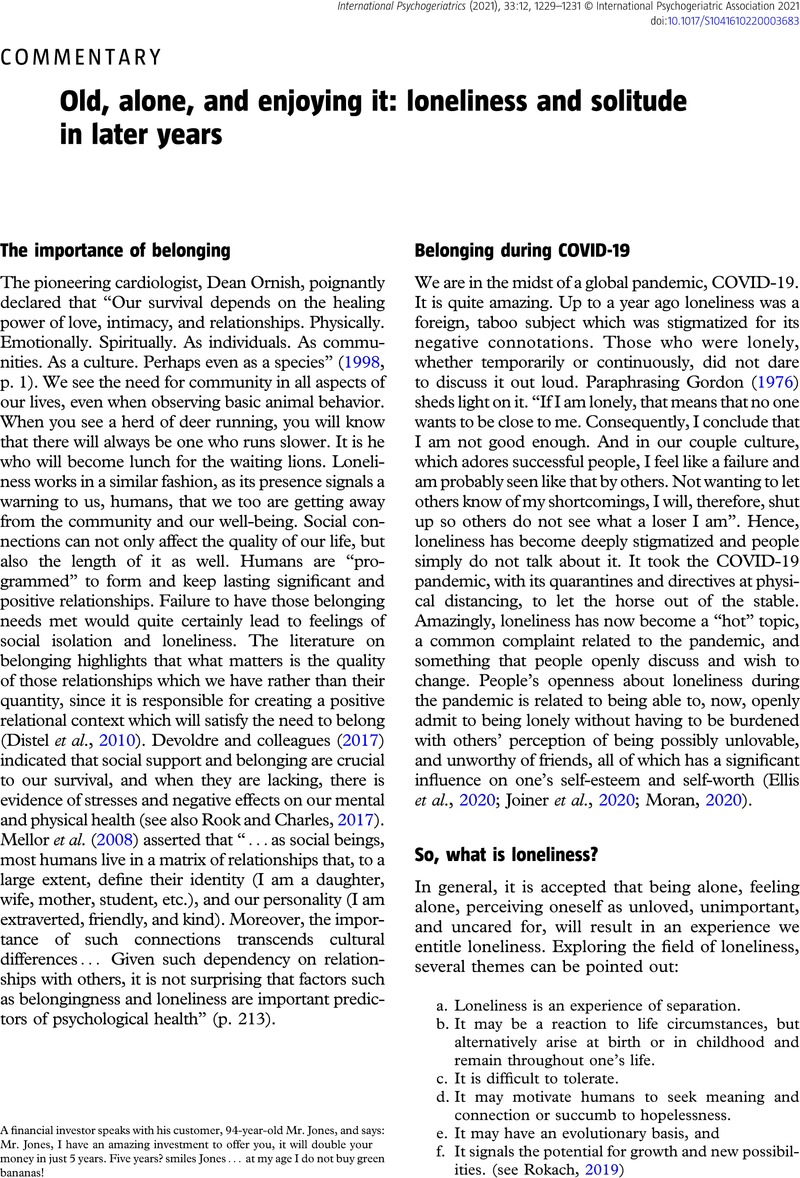No CrossRef data available.
Article contents
Old, alone, and enjoying it: loneliness and solitude in later years
Published online by Cambridge University Press: 17 December 2021
Abstract
An abstract is not available for this content so a preview has been provided. Please use the Get access link above for information on how to access this content.

- Type
- Commentary
- Information
- International Psychogeriatrics , Volume 33 , Special Issue 12: Issue Theme: Social Engagement and Mental Health , December 2021 , pp. 1229 - 1231
- Copyright
- © International Psychogeriatric Association 2021
Footnotes
A financial investor speaks with his customer, 94-year-old Mr. Jones, and says: Mr. Jones, I have an amazing investment to offer you, it will double your money in just 5 years. Five years? smiles Jones… at my age I do not buy green bananas!
References
Cacioppo, J. T. and Patrick, W. (2008). Loneliness: Human Nature and the Need for Social Connection. New York: W. W. Norton & Co.Google Scholar
Cacioppo, J. T., Hawkley, L. C. and Thisted, R. A. (2010). Perceived social isolation makes me sad: 5-year cross-lagged analyses of loneliness and depressive symptomatology in the Chicago Health, Aging, and Social Relations Study. Psychology and Aging, 25(2), 453–463. https://doi.org/10.1037/a0017216
CrossRefGoogle ScholarPubMed
Cohen-Mansfield, J., Hazan, H., Lerman, Y. and Shalom, V. (2016). Correlates and predictors of loneliness in older – adults: a review of quantitative results informed by qualitative insights. International Psychogeriatrics, 28(4), 557–576. https://doi.org/10.1017/S1041610215001532
CrossRefGoogle ScholarPubMed
Devoldre, I., David, M. H., Verhofstadt, L. L. and Buysse, A. (2017). Empathy and social support provision in couples: Social support and the need to study the underlying processes. In: Rokach, A. (Ed.), Martial Relationships and Parenting: Intimate Relations and Their Correlates (pp. 47–72). Baltimore, MD: Routledge.Google Scholar
Distel, M. A., Rebollo – Mesa, I., Abdellaoui, A., Derom, C. A., Willemsen, G., Cacioppo, J. T. and Boomsma, D. I. (2010). Familial resemblance for loneliness. Behavior Genetics, 40(4), 480–494. https://doi.org/10.1007/s10519-010-9341-5
CrossRefGoogle ScholarPubMed
Ellis, W. E., Dumas, T. M. and Forbes, L. M. (2020). Physically isolated but socially connected: psychological adjustment and stress among adolescents during the initial COVID-19 crisis. Canadian Journal of Behavioural Science, 52(3), 177–187. http://dx.doi.org/10.1037/ch0000215
CrossRefGoogle Scholar
Gawande, A. (2014). Being Mortal: Medicine and What Matters in the End. Toronto, ON: Doubleday.Google Scholar
Hawkley, L. C. and Cacioppo, J. T. (2007). Aging and loneliness: downhill quickly? Current Directions in Psychological Science, 16(4), 187–191. https://doi.org/10.1111/j.1467-8721.2007.00501.x
CrossRefGoogle Scholar
Joiner, T.E., Lieberman, A., Stanley, I.H. and Reger, M.A. (2020). Might the COVID-19 pandemic spur increased murder-suicide? Journal of Aggression, Conflict, and Peace Research, 12(3), 177–182. https://doi.org/10.1108/JACPR-05-2020-0502
CrossRefGoogle Scholar
Long, C. R. and Averill, J. R. (2003). Solitude: an exploration of benefits of being alone. Journal for the Theory of Social Behaviour, 33(1), 21–44. https://doi.org/10.1111/1468-5914.00204
CrossRefGoogle Scholar
Mellor, D., Stokes, M., Firth, L., Hayashi, Y. and Cummins, R. (2008). Need for belonging, relationship satisfaction, loneliness, and life satisfaction. Personality and Individual Differences, 45(3), 213–218. https://doi.org/10.1016/j.paid.2008.03.020
CrossRefGoogle Scholar
Moran, G. (2020). Combating Loneliness When You Live Alone and Work from Home. London: Fast Company. https://www.fastcompany.com/90503812/combatting-loneliness-when-you-live-alone-and-work-from-home
Google Scholar
Ornish, D. (1998). Love & Survival: The Scientific Basis for the Healing Power of Intimacy. New York: HarperCollins.Google Scholar
Ost-Mor, S., Palgi, Y. and Segel-Karpas, D. (2020). Exploring gaps in positive solitude perceptions: older adults vs. gerontology professionals. International Pyschogeriatrics. https://doi.org/10.1017/S1041610220003555
CrossRefGoogle Scholar
Parse, R. R. (2007). The humanbecoming school of thought it 2050. Nursing Science Quarterly, 20(4), 308–311. https://doi.org/10.1177/0894318407307160
CrossRefGoogle ScholarPubMed
Rokach, A. (1988). The experience of loneliness: a tri – level model. The Journal of Psychology, 122(6), 534–544. https://doi.org/10.1080/00223980.1988.9915528
CrossRefGoogle Scholar
Rokach, A. (2019). The Psychological Journey to and from Loneliness: Development, Causes, and Effects of Social and Emotional Isolation. Cambridge, MA: Academic Press.Google Scholar
Rokach, A., Matalon, R., SaFarov, A. and Bercovitch, M. (2007). The dying, those who care for them, and how they cope with loneliness. American Journal of Hospice and Palliative Medicine, 24(5), 399–407. https://doi.org/10.1177/1049909107305652
CrossRefGoogle ScholarPubMed
Rook, K. S. and Charles, S. T. (2017). Close social ties and health in later life: Strengths and vulnerabilities. American Psychologist, 72(6), 567–577. https://doi.org/10.1037/amp0000104
CrossRefGoogle ScholarPubMed
Rubenstein, C. M. and Shaver, P. (1982). The experience of loneliness. In: Peplau, L. A. and Perlman, D. (Eds.), Loneliness: A Sourcebook of Current Theory, Research and Therapy (pp. 206–223). New York: John Wiley & Sons.Google Scholar


